|
Page 1
Welcome to the Butterfly Shelf of the Fauna Room.
Butterflies of the Florida Keys
Text is below each image.
This page by Jerry Wilkinson
-
Butterfly Gardening is Encouraged.
Adult butterflies
can be found all months in the Keys with February the least; however, the
ranges of species vary only from about 54 to 72. Five families
of butterflies regularly appear in the Keys. They are the Papilionidae
(Swallowtails), Nymphalidae (Brush-footed), Hesperiidae (Skippers), Pieridae
(Whites and Suphurs) and Lycaenidae (Hairstreaks and Blues). In their
book Butterflies of the Florida Keys, Marc Minno and Thomas Emmel
show color plates of 106 species reported in the Florida Keys. The loss
of and threatened habitat is considered the most critical. Both host and
food plants will be necessary for survival. Aerial spraying for mosquito
control is considered problematic and new insecticides are being studied.
--------------------
-Family Papilionidae-
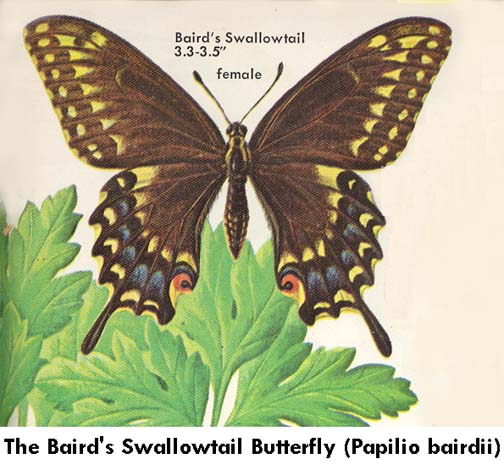 Swallowtails are probably the best known of North
American butterflies and are of the family Papilionidae, but are
found throughout the world. Their colors are quite variable and range from
almost yellow to almost black.
-
Swallowtails are probably the best known of North
American butterflies and are of the family Papilionidae, but are
found throughout the world. Their colors are quite variable and range from
almost yellow to almost black.
-
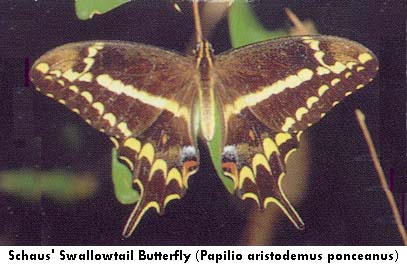 The Schaus' is one of the seven listed as endangered
of the 573 Swallowtail Butterflies species worldwide. Originally an occupant
of the entire Upper Keys, their numbers are down to somewhere in the low
100s now. In 1911, William Schaus collected specimens in the Miami area.
Loss of habitat and pesticides are attributed to their decline. They lay
their eggs in the torchwood and wild lime trees on North Key Largo. Only
a few contemporary people have actually seen the Schaus'.
The Schaus' is one of the seven listed as endangered
of the 573 Swallowtail Butterflies species worldwide. Originally an occupant
of the entire Upper Keys, their numbers are down to somewhere in the low
100s now. In 1911, William Schaus collected specimens in the Miami area.
Loss of habitat and pesticides are attributed to their decline. They lay
their eggs in the torchwood and wild lime trees on North Key Largo. Only
a few contemporary people have actually seen the Schaus'.
Other Papilionidae seen the Keys have
been: Polydamous, Cuban Kite, Bahama, Giant and Palamedes.
----------------------------
- Family Nymphalidae -
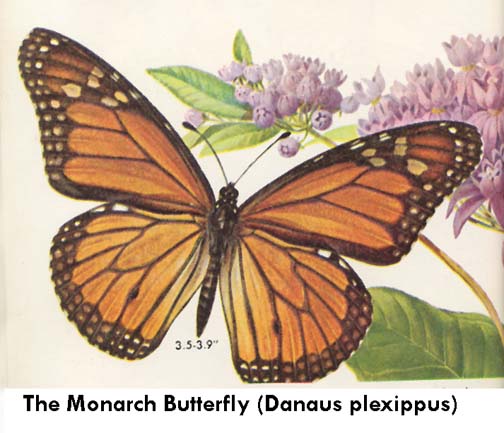
-
The Monarch is of the Milkweed Butterflies of
the family Nymphalidae and is one of the two species found in North America.
It may be the best known butterfly and is noted for its migrations. Allegedly,
they have a disagreeable taste to birds and this may account for their
great numbers.
-
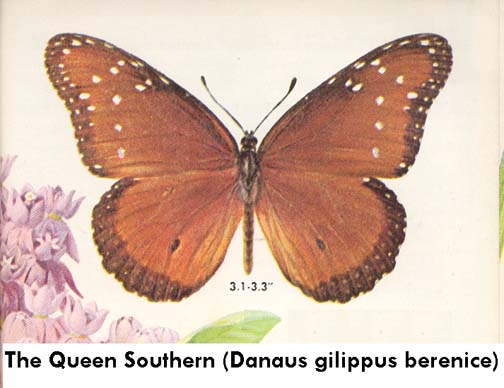
Another of the family Nymphalidae is its cousin
shown above, the Queen Butterfly, resembles the Monarch but is smaller,
darker and not as brilliant. Butterflies are cold blooded animals. Beetles
are the only other insect that have more species than the butterfly.
-
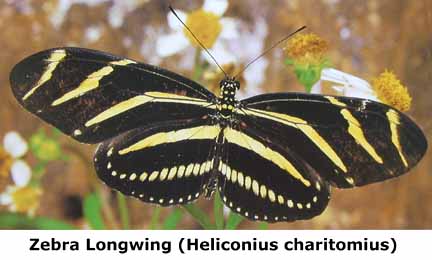 The Zebra Longwing of the family Nymphalidae
is the Florida State official butterfly and the adult is shown above. This
zebra has a rather short life span; therefore its color variations can
be many in a year's time. It can be seen in the Florida Keys but is more
popular in the Everglades.
-
The Zebra Longwing of the family Nymphalidae
is the Florida State official butterfly and the adult is shown above. This
zebra has a rather short life span; therefore its color variations can
be many in a year's time. It can be seen in the Florida Keys but is more
popular in the Everglades.
-
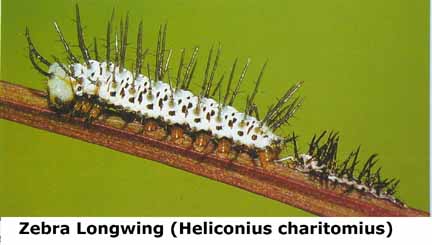 Butterflies are vociferous eaters, molts
its skin about five times before it pupates.
-
Butterflies are vociferous eaters, molts
its skin about five times before it pupates.
-
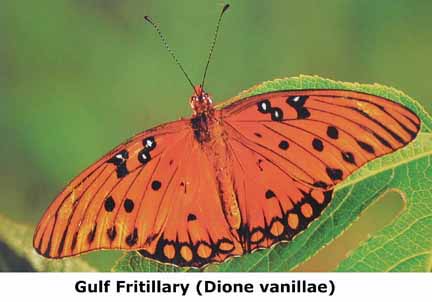 The Heliconians are a subfamily of the Nymphalidae,
the passion flower butterflies. The Gulf Fritillary larvae feeds on the
passion flower which is found in the Florida Keys. The adult feeds on lantana,
thistle and passionflower and has a life span of about one month. Some
of the various stages of the Gulf Fritillary's life is shown below.
-
The Heliconians are a subfamily of the Nymphalidae,
the passion flower butterflies. The Gulf Fritillary larvae feeds on the
passion flower which is found in the Florida Keys. The adult feeds on lantana,
thistle and passionflower and has a life span of about one month. Some
of the various stages of the Gulf Fritillary's life is shown below.
-
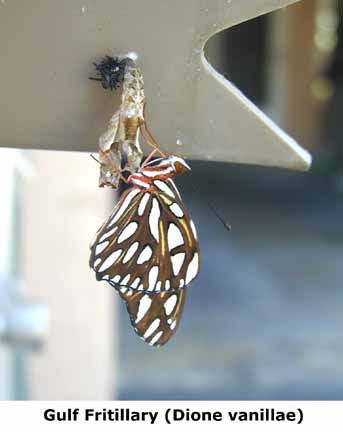 The above young fritillary has just emerged from
its pupae and is drying its wings. It flew away about 10 minutes after
the above photo was taken. Note the different coloration of the undersides
of the wings. Most butterflies have different color patterns on each side
of its wings. The usually brighter patterns are on the top and is used
to attract an mate. The underside is duller and better serves as a camouflage;
therefore it usually sits with its wings folded.
-
The above young fritillary has just emerged from
its pupae and is drying its wings. It flew away about 10 minutes after
the above photo was taken. Note the different coloration of the undersides
of the wings. Most butterflies have different color patterns on each side
of its wings. The usually brighter patterns are on the top and is used
to attract an mate. The underside is duller and better serves as a camouflage;
therefore it usually sits with its wings folded.
-
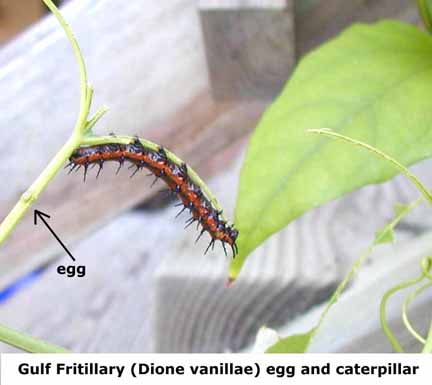 An idea of the growth of the fritillary from its
egg to caterpillar. Butterflies normally deposit their eggs on a specific
plant; therefore, destruction of fauna can be fatal to butterflies. In
the Keys the plant is passion flower (preferably the P. suberosa) which
is one of the three native passion flowers.
-
An idea of the growth of the fritillary from its
egg to caterpillar. Butterflies normally deposit their eggs on a specific
plant; therefore, destruction of fauna can be fatal to butterflies. In
the Keys the plant is passion flower (preferably the P. suberosa) which
is one of the three native passion flowers.
-
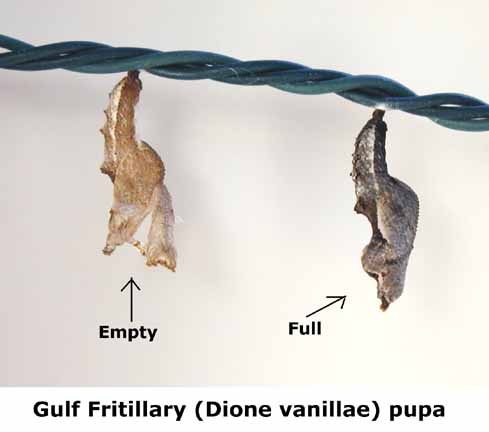 Two pupa suspended from an electric cord just
above the passion flower shown above.
Two pupa suspended from an electric cord just
above the passion flower shown above.
About 30 other Nymphalidae butterflies
in five subfamilies have been seen and photographed in the Keys. Some are
Red Admiral, Banded Orange, Black Mangrove, Common Buckeye, Cuban Peacock,
Cuban Crescent, White Peacock, Julia, Florida Purple Wing, and Ruddy
Dagger Wing.
--------------------
- Family Peridae -
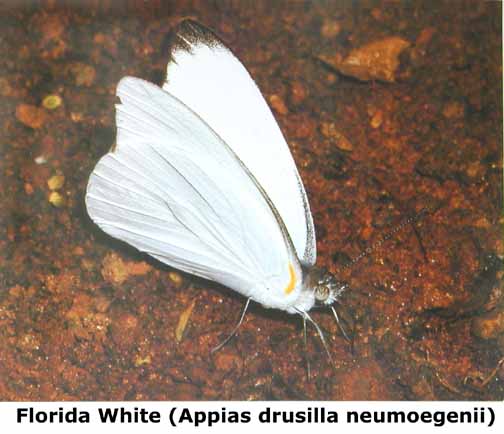
Of the family Peridae the Florida White
shown above and the Great Southern White are frequently seen in all the
Keys. The Florida White are mostly seen hammock areas and the Great Southern
White in marshy areas. -
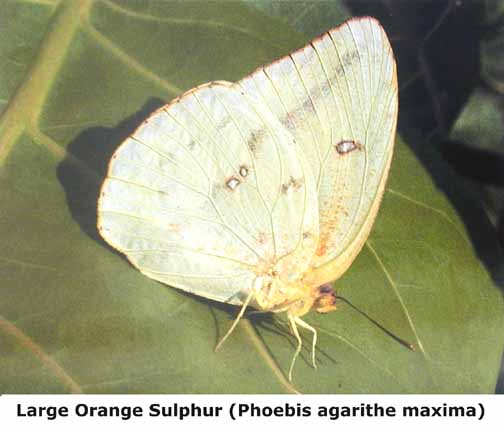 The Large Orange Sulphur are mostly found in southern
Florida. The caterpillar prefers cats claw and wild tamarind which are
found abundantly in the Keys. The adult feed on a large variety of flowers.
-
The Large Orange Sulphur are mostly found in southern
Florida. The caterpillar prefers cats claw and wild tamarind which are
found abundantly in the Keys. The adult feed on a large variety of flowers.
-
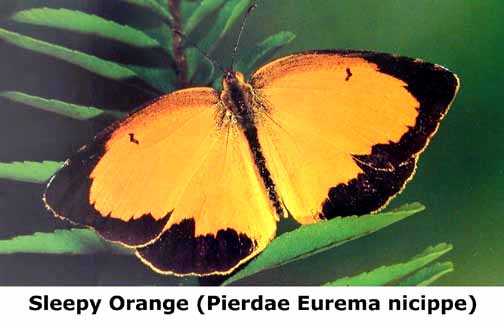 The Sleepy Orange is seldom seen in wooded areas
and appears to prefer scarified and weedy areas. For some reason they are
not seen as often in the Upper Keys, presumably because of the lack of
host plants. They are mostly a summer butterfly in the Keys.
The Sleepy Orange is seldom seen in wooded areas
and appears to prefer scarified and weedy areas. For some reason they are
not seen as often in the Upper Keys, presumably because of the lack of
host plants. They are mostly a summer butterfly in the Keys.
At least 30 other Pieridae have
been photographed in the Keys of which some are: Giant Brimstone (rare),
Checkered White, Jamaican Sulphur, Barred Sulphur, Cloudless Sulphur and
Orange Barred Sulphur.
-------------------------
- Family Lycaenidae -
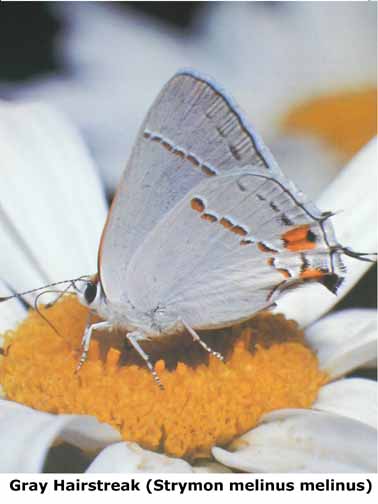 Family Lycaenidae (Gossamer wings). The
larvae of the Gray Hairstreak shown above is not as picky eater as some
but in the Keys the hibiscus is a good food source. The adult can usually
find milkweed in the Keys, but many other foods are consumed on the mainland.
It is found throughout the U.S.
-
Family Lycaenidae (Gossamer wings). The
larvae of the Gray Hairstreak shown above is not as picky eater as some
but in the Keys the hibiscus is a good food source. The adult can usually
find milkweed in the Keys, but many other foods are consumed on the mainland.
It is found throughout the U.S.
-
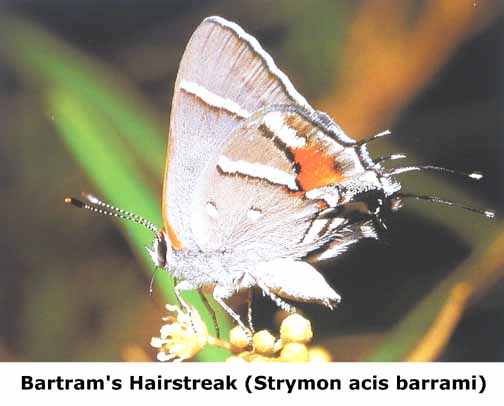 Another Lycaenidae is Bartram's Hairstreak named
after William Bartram who in the early 1700s explored Florida. It was once
thought threatened but appears to be replenishing. In the Keys it is found
mostly in the pinelands of the lower Keys.
Another Lycaenidae is Bartram's Hairstreak named
after William Bartram who in the early 1700s explored Florida. It was once
thought threatened but appears to be replenishing. In the Keys it is found
mostly in the pinelands of the lower Keys.
Not many of the Lycaenidae are easily
found in the Keys. The Cuban Gray, Modest Hairstreak, Miami Blue and Cassius
Blue are perhaps the easiest. The Ceraunus Blue, Eastern Pigmy Blue,
Light Banded Hairstreak, Disguised Hairstreak and Atala Hairstreak are
more difficult.
---------------------------
- Family Hesperiidae -
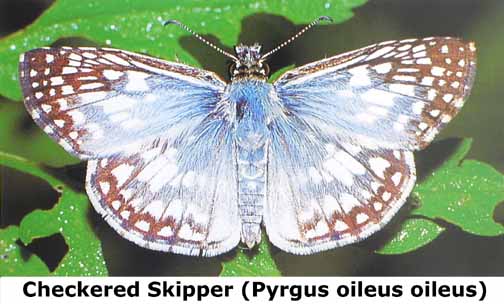 Another of the family Hesperiidae, the
Tropical Checkered Skipper is shown above. Larvae feed on the hibiscus
and mallow plants. They fly low in weedy and disturbed areas. The females
are darker than the males.
-
Another of the family Hesperiidae, the
Tropical Checkered Skipper is shown above. Larvae feed on the hibiscus
and mallow plants. They fly low in weedy and disturbed areas. The females
are darker than the males.
-
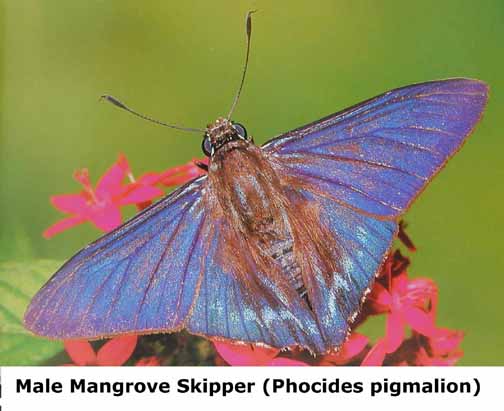 The caterpillar of the Mangrove Skipper feeds
on the leaves of the red mangrove. The female is not as brightly colored
and as most butterflies, she lays her eggs on the same plant that the larvae
will need for food. The Mangrove skipper can be confused with a moth
as it has a furry type body.
The caterpillar of the Mangrove Skipper feeds
on the leaves of the red mangrove. The female is not as brightly colored
and as most butterflies, she lays her eggs on the same plant that the larvae
will need for food. The Mangrove skipper can be confused with a moth
as it has a furry type body.
One of the larger families, mainly in two
subfamilies, found in the Keys is the Hesperiidae. The
Long Tailed, Dorantes, Hammock, Zestos and Zarucco Dusty Wing are some
of the Skippers. Of the Branded Wing Skippers, the Field, Fiery, Eufala,
Monk, Broken Dash and Obscure are perhaps the most common found.
---------------END----------------
-
Additional reading and research noted by the author:
Butterflies of the Florida Keys, Minno and Emmel, Scientific publishers,
1993
Florida's Fabulous Butterflies, Thomas Emmel, World Publications, 1997
The Butterfly Garden, Jerry Sedenko, Villard Books, 1991
Florida Butterfly Gardening, Minno and Minno, University of Florida
Press, 1999
Passion Flowers, John Vanderplank, The MIT Press, 1991
The Butterflies of North America, James Scott, Stanford University
Press, 1986
Peterson Field Guide - Eastern Butterflies, Opler and Malikul, Houghton
Mifflin Co., 1992
Butterfly World, Ronald Boender, Butterfly World Ltd., Coconut Creek,
Florida, 1990
-
Return to Fauna Case, or
-
Return to Natural History Room
|

















